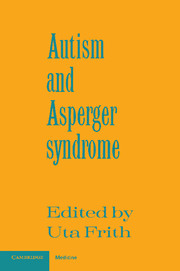Book contents
- Frontmatter
- Contents
- List of illustrations
- Acknowledgements
- 1 Asperger and his syndrome
- 2 ‘Autistic psychopathy’ in childhood
- 3 The relationship between Asperger's syndrome and Kanner's autism
- 4 Clinical and neurobiological aspects of Asperger syndrome in six family studies
- 5 Asperger syndrome in adulthood
- 6 Living with Asperger's syndrome
- 7 The autobiographical writings of three Asperger syndrome adults: problems of interpretation and implications for theory
- Name Index
- Subject Index
3 - The relationship between Asperger's syndrome and Kanner's autism
Published online by Cambridge University Press: 18 December 2009
- Frontmatter
- Contents
- List of illustrations
- Acknowledgements
- 1 Asperger and his syndrome
- 2 ‘Autistic psychopathy’ in childhood
- 3 The relationship between Asperger's syndrome and Kanner's autism
- 4 Clinical and neurobiological aspects of Asperger syndrome in six family studies
- 5 Asperger syndrome in adulthood
- 6 Living with Asperger's syndrome
- 7 The autobiographical writings of three Asperger syndrome adults: problems of interpretation and implications for theory
- Name Index
- Subject Index
Summary
A year before Asperger's first on ‘autistic psychopathy’ appeared, Kanner (1943) published his famous first account of eleven children with a pattern of abnormal behaviour that he decided to call ‘early infantile autism’. He began as follows: ‘Since 1938, there have come to our attention a number of children whose condition differs so markedly and uniquely from anything reported so far, that each case merits – and I hope will eventually receive – a detailed consideration of its fascinating peculiarities’.
The characteristics of Kanner's syndrome
Kanner pointed out that these children had a number of characteristics in common. Kanner and Eisenberg (1956) selected five diagnostic criteria from Kanner's descriptions. Kanner's own words are given in quotation marks. The expansions and examples are based on his descriptions and my clinical experience.
‘A profound lack of affective contact with other people’. When young, the children appear aloof and indifferent to other people, especially other children. Kanner wrote: ‘There is, from the start, an extreme autistic aloneness that, wherever possible, disregards, ignores, shuts out anything that comes to the child from outside’. Their parents describe them as ‘self-sufficient’, ‘like in a shell’, ‘acting as if people weren't there’, ‘happiest when alone’.
[…]
- Type
- Chapter
- Information
- Autism and Asperger Syndrome , pp. 93 - 121Publisher: Cambridge University PressPrint publication year: 1991
- 102
- Cited by



